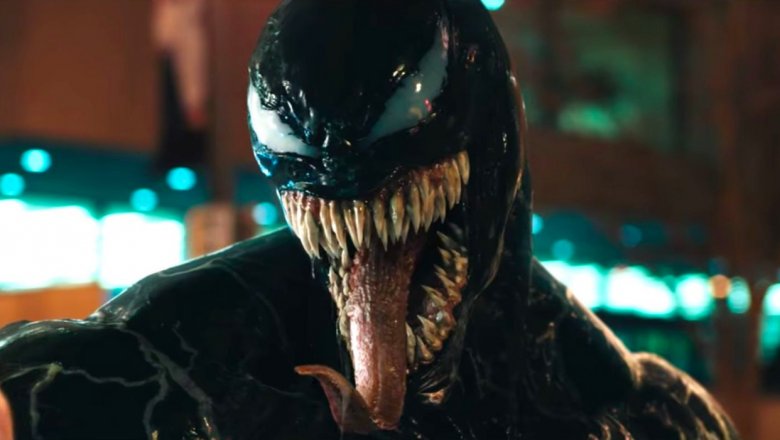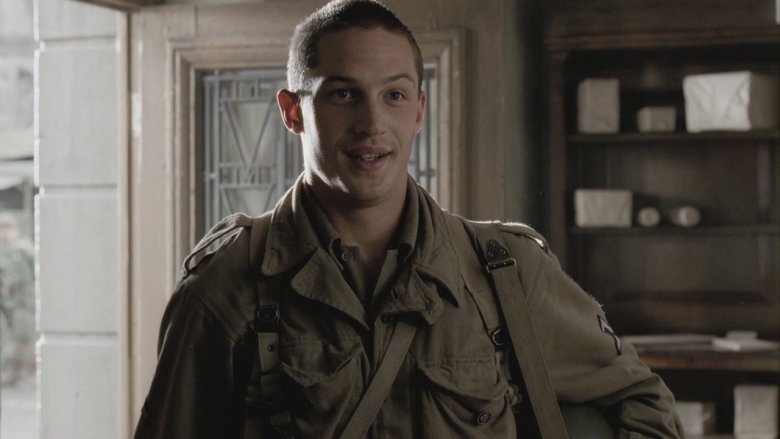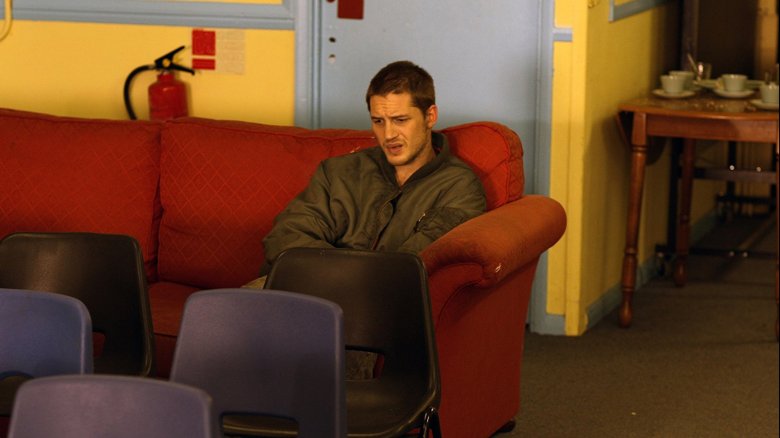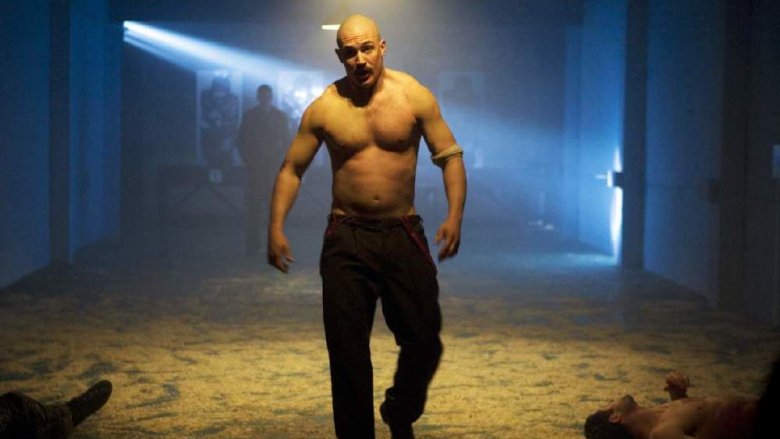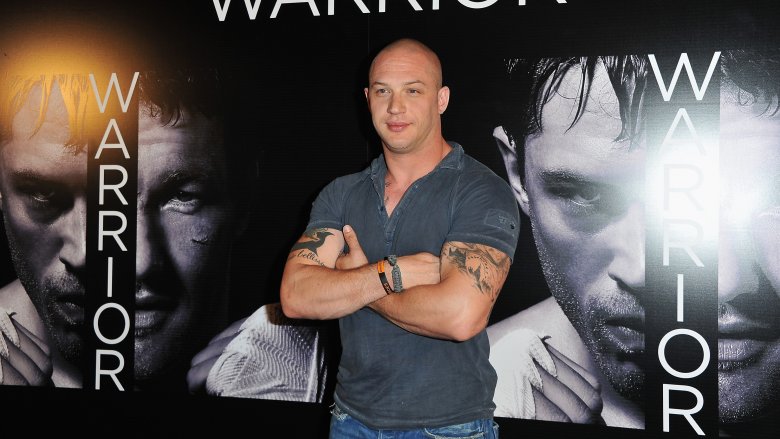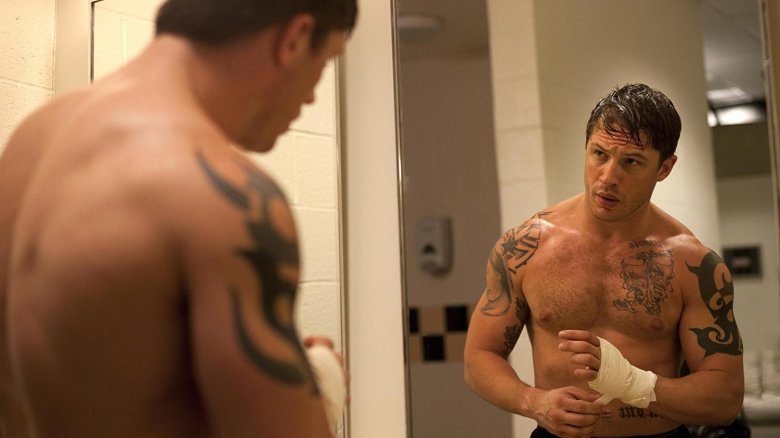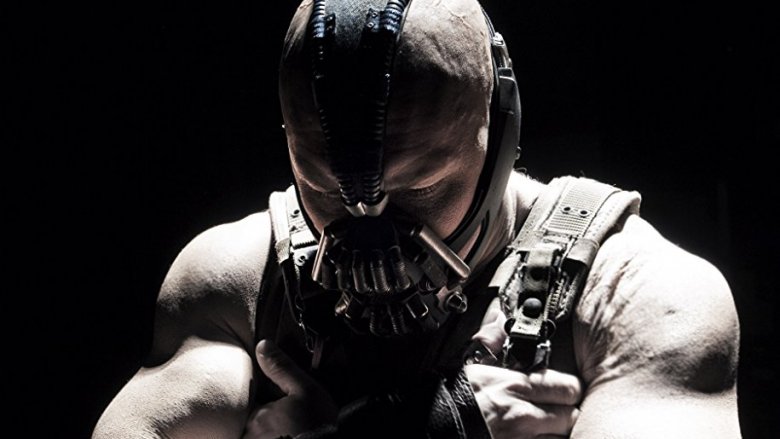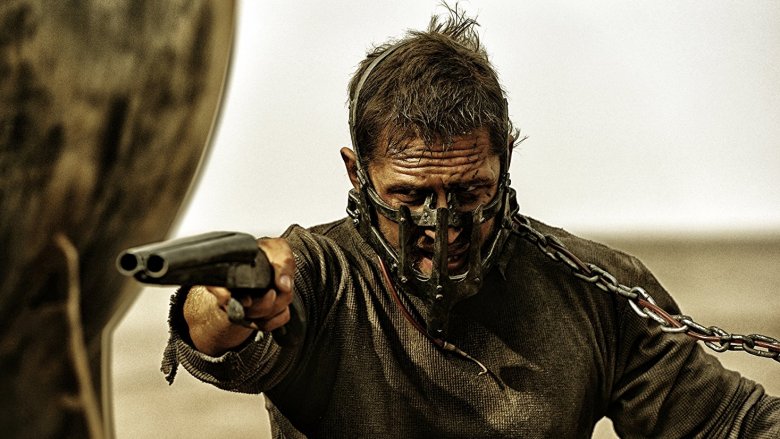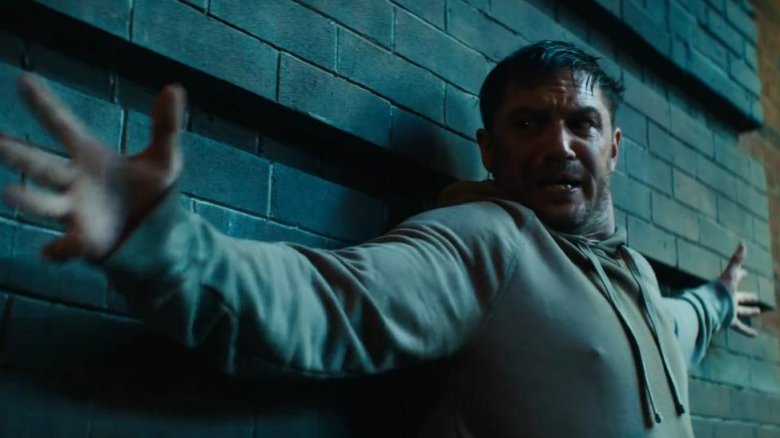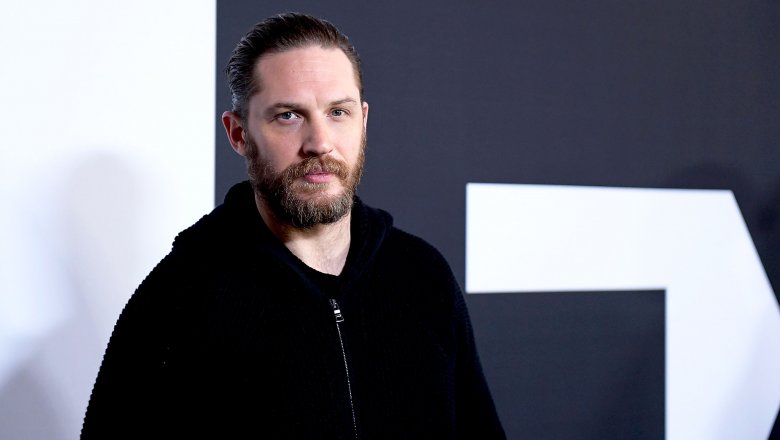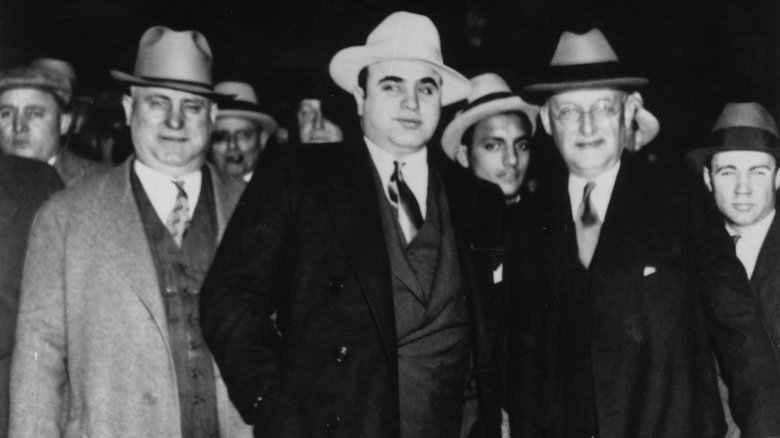How Tom Hardy Got Ripped To Play Venom
One terrifying glance at Venom is all it takes to know this year's Spider-Man spin-off has the potential to be much darker, and much more disturbing, than any previous Marvel comic book adaptation. Venom's crooked, slime-covered grimace is befitting of the characters Tom Hardy tends to portray: dangerous, cold, calculating, with an undercurrent of rage and vulnerability in equal measure.
Hardy has built his reputation channeling hardened oddballs. Notably, his dedication to his acting craft is matched only by his willingness to physically adapt, role by role. The 40-year-old's career is marked by memorable physical transformations, from Bane to Bronson — a calorie-filled, muscle-building journey to A-list status. As the man himself wryly noted, those in the industry didn't pay attention to him until he "started putting on weight and kicking people and being aggressive."
Chalk up the hands, cut the carbs, up the protein, and get ready to work hard. Here's a rundown of a career's worth of physical transformations, all preparing Hardy to get ripped for Venom.
An unlikely athlete
It's surprising considering his physical accomplishments, but Tom Hardy is far from a natural athlete. As a child, Hardy was "small and skinny and vulnerable." He told Esquire he is the antithesis of many of the characters he plays; he doesn't feel "very manly" or "strong," two words many film lovers easily associate with the actor. In his younger years he was so intimidated by male company, lifting weights wasn't a viable option. "I couldn't go into a gym because of the testosterone, and I felt weak," he said.
Part of the actor's vulnerability comes through direct understanding. In his early 20s, he was addicted to alcohol and crack cocaine, a far cry from the clean living and intense physical training he has since adopted. After his breakthrough in 2001, with Band of Brothers and Black Hawk Down, his addiction escalated. After a "near-death experience," Hardy managed to overcome his addiction after checking into rehab in 2003. He has been clean since.
So how did the unlikely athlete go from gym-phobic to musclebound? Hardy told The Independent bulking up was a conscious attempt to "establish myself as someone you would take notice of and further my employment." Suffice to say, the plan worked.
Dropping weight for Stuart: A Life Backwards
Hardy's first physical change was losing weight to portray homeless heroin addict Stuart Shorter in Stuart: A Life Backwards. Hardy starred opposite Benedict Cumberbatch in the dramatisation of Alexander Masters' biography, released in 2007. Aged 29 at the time of filming, Hardy lost two stones (12.5kg) to realistically portray Shorter, who had muscular dystrophy.
However, Hardy took a healthier approach than peers such as Christian Bale, who notoriously survived on apples, coffee, and tinned tuna when dropping 60lbs for 2004's The Machinist. "I was fitter than I've ever been after that," he told Irish Times. Working with a personal trainer, Hardy avoided severe calorie restrictions — "I needed my brain" — instead losing weight in a manageable way.
A calorie deficit was still essential to drop the pounds, but to help speed up the process, Hardy incorporated cardio, running miles and miles each day. His diet was rich in protein, including "as much spinach and greens as I wanted." Keeping the muscle-building macronutrient at high levels during this process is essential to avoid excessive muscle breakdown, known as catabolism. Fortunately for the actor, the "easy" training and diet regime lasted a tolerable five or six weeks.
Bulking up for Bronson
Few would have seen the actor's potential to portray Charles Bronson, Britain's most violent prisoner, following his BAFTA-nominated role as Shorter. Standing at 5'10", Hardy weighed in at 150lbs when he began training for the lead role in Bronson. No amount of mimicry would do justice to the formidable, moustache-wearing, hostage-taking criminal, though. Hardy needed to convincingly look the part, which required packing on some serious weight.
Just a year after cutting the pounds for Shorter, Hardy made his most notable transformation in his career-defining role. Impressively, Hardy only had five weeks to bulk up via his "four walls and the floor" prisoner-esque bodyweight workout regime. Mass, not definition, was the number one goal. The actor had increase in size, quickly. In a "race against the clock," Hardy put on a staggering seven pounds per week in preparation, for a combined total of two-and-a-half stone.
Though Hardy did stick to the bodybuilding staple of chicken and rice, he was given some room to play. Coca-Cola, pizza and Häagen-Dazs ice cream were allowed. "I needed to put a layer of fat on my body, because Bronson when he was younger was a big guy, a brawler," he told Ask Men. His hard work paid off: though the real-life Bronson was initially concerned about Hardy's physicality, Hardy won his approval with his drastic transformation, and caught the eye of Hollywood executives.
The ex-Marine credited with Hardy's transformation
Of course, diet isn't the only factor in changing body composition. To adequately portray Bronson, Hardy needed to add mass to his neck, chest, and forearms. Serious working out was required to put excess calories to good use, building musculature beneath the layer of fat. Hardy turned to his long-term friend and ex-Marine, Patrick 'Pnut' Monroe. "[He's] everything I always wanted to be," Hardy told Men's Health. "He's done so much and he's potentially a truly dangerous, fierce man. But he's the softest guy I've ever met."
Pnut takes an unconventional approach to training that is anything but soft. The man credited with Hardy's physical changes opts for a technique he refers to as "signalling," a deviation from the normal body transformations seen in Hollywood. The likes of Black Panther's Chadwick Boseman and Thor's Chris Hemsworth stick to conventional bodybuilding routines — a few hours spent in the gym strength training, sticking to a moderate amounts of reps to build muscle mass. Pnut's routine, however, involves regular workouts with the intention of "sending signals to the muscles you want to develop as often as possible." In addition, his routines introduce lots of variation to force the body to constantly adapt, making "every rep difficult."
Although individual signalling session aren't as intense as conventional weightlifting, avoiding complete muscle failure, some routines are spread through the entire day, with little time off. As for results, look no further than Hardy's role following Bronson ...
Upping intensity for Warrior
Eating pizza, swigging cola, and indulging in ice cream doesn't sound too bad, does it? As admirable as Hardy's metamorphosis into uber-violent Bronson was, his return for Warrior visually represents the actor's impressive discipline. He didn't only pack on size playing Marine-turned-MMA fighter Tommy Conlon, but added slabs of lean muscle. The former skinny kid was left long behind; with no previous training in MMA, Hardy transformed into a convincing athlete. Naturally, such results weren't easy to attain.
Simultaneously, he both lost 15 percent of his total body fat and also gained twenty kilograms of raw muscle, a byproduct of intensive training. Even reading his routine aloud leaves most short of breath: for two months, his days were filled with two hours of boxing, two hours of Muay Thai, two hours of Jiu-Jitsu, two hours of choreography, and two hours of weight lifting. During his training, he bulked up from 162 pounds to upwards of 179 pounds — 29 pounds heavier than when he began training for Bronson. Sadly, Hardy waved goodbye to junk food, surviving on five or six high-protein meals per day, consisting of chicken, broccoli, and low carbs.
Trainer Pnut was on board when weight training was required in Hardy's regime, working on different muscle groups each day. Eccentricity was a given. The 100-kilogram personal trainer stuck to his philosophy of signalling, adding resistance-training. This included Hardy doing push-ups against Pnut, arm-wrestling, and, most extreme, lifting weights with his teeth to build his neck muscles.
Adding even more size for Bane
Hardy's transformations are unique. He doesn't simply get bigger or smaller, but his body shape appears to be in constant flux, as adaptable as his artistic demeanor. This comes down to two elements: muscle mass and body fat. Bronson required pure bulk, whereas Warrior required definition and athleticism. As the masked villain Bane in The Dark Knight Rises, Hardy needed to appear larger than life, a result achieved by packing on even more size to his already-muscular physique.
To adequately capture Batman's brawling, back-snapping baddie, Hardy added a total of 30 pounds, taking his total to close to 200 pounds — a whopping 50 pounds heavier than pre-Bronson. Similar to his Bronson plan, Hardy's goal included "a lot of fat and trickery" with no cardio training was required. Diet would've been the biggest factor in adding so much mass in a short space of time, with a high calorific surplus. However, with muscle mass increase limited to an absolute maximum of half a pound per week, Hardy would've presumably undertaken a "dirty bulk" — the term given for putting on as much weight in as little time, with an increase in fat and muscle. Hardy's regime wouldn't have changed too much. However, restricted cardio also requires a lower heart rate during resistance training. It's likely Pnut will have increased rest time between sets to three to five minutes, focusing on strength-based training ahead of stamina.
Losing mass again for Max
Mad Max: Fury Road isn't the first movie that'll spring to mind when thinking of Hardy's body sculpting journey, as Max Rockatansky isn't a particularly ripped character. Melting Hardy into the unsaturated, dehydrated chaos of George Miller's post-apocalyptic wasteland required a drastic 30-pound weight loss — the same amount gained for Bane. With no need for intimidation or athleticism, what was the desired look? "Imagine a hungry wolf. Or like when you put a cat in the bath," he told Collider. "This is the kind of guy who's not well. So I have to create that reality."
Preparation was a far cry from the hours and hours of graft for Warrior. Although Hardy undertook stunt training to fit with Miller's use of practical effects, Hardy reached his goal with "smoking and one meal per day." Once the weight was dropped, the next step was three or four months of fight training. There was no resting once cameras were rolling, either. "It's a very physical shoot, from the training to the six months on the ground," he told Men's Fitness. "You were physically active, all day, every day."
Finding his inner Venom with MMA
So, we reach the critical point of this article: how did Tom Hardy get ripped to play Venom? By the time production began in October 2017, Hardy was already a seasoned professional at adapting his body. He'd already trained extensively for Warrior. He already knew how to push himself beyond limits. So the short answer is, Hardy got ripped by applying tools he'd accumulated over years of hard work, with no quick fix or magic ingredient.
Despite previous experience, Hardy still required guidance from professional MMA fighter Nathan Jones and personal trainer Mark Mene. He trained in a combination of boxing, MMA, and kickboxing. Judging from a sparring video Jones posted on Instagram, Hardy has adapted to the challenge quickly. "He's got power. I like that. He's got that fight in him," said British welterweight fighter Jones. That fight is crucial in keeping Hardy motivated when the going gets tough. His routine stretches over five days each week — including some days with two sessions.
Hardy has a lot to live up to, given Venom's formidable reputation as Spider-Man's greatest foe. But considering the actor's ability to fully commit to a role, mentally and physically, there should be no doubts. Trainer Mene agrees. "The world is going to see the darkest and most powerful supervillain that Marvel have ever created," he said. Peter Parker, watch out ...
The changes have taken a toll on his body ...
Publicity surrounding Hardy's preparation for Venom has been limited to his training regime, with little word on his diet or body composition. While it's clear he's still in fighting shape, that could be due to a conscious decision to stop pushing his body to extremities. "I've probably damaged my body too much," he told The Daily Beast. "I'm only little! If I keep putting on weight I'll collapse like a house of cards under too much pressure."
Though in his younger days Hardy found the process bearable, his advancing years require a more measured approach to training. "As you get into your 40s you have to be more mindful of the rapid training, packing on a lot of weight and getting physical," he said. In Hollywood, conflicting schedules are often an issue: Hardy spent three months training for Bane while also filming Lawless. "To go from one extreme to another has a cost. I haven't damaged my body, but I'm certainly a bit achier than I used to be."
... but there could be more transformations to come
Years have passed since Hardy's conscious decision to pack on muscle to reach the dizzying heights of Hollywood's elite. Physical transformations are no longer necessary. The job is done. Hardy has proven his acting finesse far exceeds his aesthetic figure: his performance as John Fitzgerald in 2015's The Revenant earned an Oscar nomination for Best Supporting Actor; he's convincingly portrayed both Kray twins in Legend; commanded screen-time in Locke; fronted a hugely popular, richly decorated franchise in Mad Max: Fury Road; and partnered with one of cinema's most talented directors, Christopher Nolan, in Inception, The Dark Knight Rises, and Dunkirk.
Hardy doesn't have to physically transform to win roles anymore. But this man lives and breathes dedication. He confirmed that his upcoming role as infamous gangster Al Capone in Josh Trank's 2019 biopic, Fonzo, definitely involves a transformation. "He'd lost a lot of weight before he passed because he was suffering from Syphilis and deteriorating," he told The Daily Beast. "It's not the classic Al Capone that you necessarily envision with the silhouette." As always, Hardy remains unconventional.
It's not guaranteed Al Capone will be the last Tom Hardy transformation, either. The skinny guy turned beefy brawler, the drug addict turned athletic actor, Hardy is at home giving blood, sweat, and tears to the cause of transformation. And if transformations comes with the territory, how could he ever say no?
